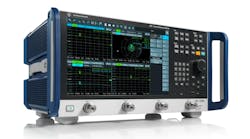Baseband VST Aims to Solve Tomorrow’s Test Requirements (.PDF Download)
Last year, National Instruments (NI) made headlines by introducing the PXIe-5840, the company’s second-generation vector signal transceiver (VST; see "RF Measurement Modularity Redefined." Covering a frequency range of 9 kHz to 6 GHz, the PXIe-5840 can achieve 1 GHz of instantaneous bandwidth. Not resting on its laurels, NI again made news earlier this year by unveiling the PXIe-5820 baseband VST.
The PXIe-5820 baseband VST can achieve 1 GHz of in-phase/quadrature (I/Q) instantaneous bandwidth for generation and analysis. The new VST combines a wideband I/Q digitizer, wideband I/Q arbitrary waveform generator (AWG), and user-programmable field-programmable gate array (FPGA) into a single instrument. Furthermore, this capability is all contained in a single two-slot PXI Express module.
The PXIe-5820 is well suited to meet the needs of next-generation wireless communications, such as 5G and IEEE 802.11ax. Specifically, the PXIe-5820 VST can achieve an error vector magnitude (EVM) of better than -54 dB when utilizing the IEEE 802.11ax 1024-QAM modulation scheme.








